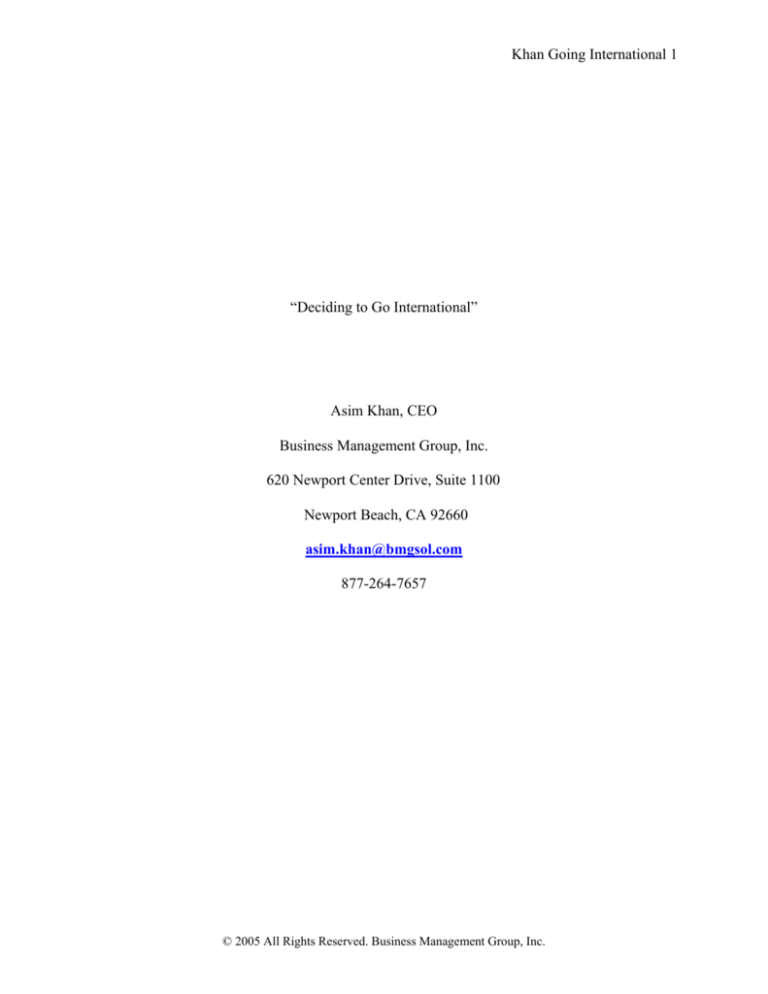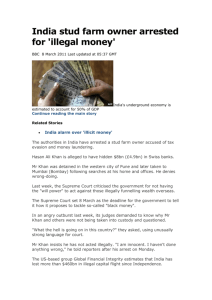
Khan Going International 1
“Deciding to Go International”
Asim Khan, CEO
Business Management Group, Inc.
620 Newport Center Drive, Suite 1100
Newport Beach, CA 92660
asim.khan@bmgsol.com
877-264-7657
© 2005 All Rights Reserved. Business Management Group, Inc.
Khan Going International 2
Author Biography
Asim Khan is the Chief Executive Officer of Business Management Group, Inc., a
consulting firm that specializes in engineering, marketing and management. His international
business experience spans a wide range of industries, including commodities, energy, aerospace,
defense, electronics, manufacturing, computers and technology, health care, publishing and
financial services. In addition to his role as an executive consultant, Asim has served on the
boards of directors for several corporations and nonprofit organizations. He holds a bachelor’s
degree in Business Administration and a master’s degree in Technology Management from the
University of Phoenix. Mr. Khan is also an Honorary Chairman on the National Republican
Congressional Committee’s Business Advisory Council.
.
Khan Going International 3
Executive Summary
There are many benefits to marketing a company’s products or services overseas, but the
decision to go international must be made carefully. Cultural and language barriers, political
issues and variations in religious beliefs, societal norms, and business negotiation styles impact
how business should be conducted with international counterparts. Two steps can prepare an
organization for an overseas effort. First, an international marketing plan must be developed, and
second, the organization must determine how it will enter the new market. Since creation of a
dedicated export department can be an overwhelming and expensive task, an alliance with an
outside party can reduce the time and effort it takes to become established in a foreign market.
One option is to establish a joint venture. Another is the use of an export management company
(EMC). An EMC has contacts and knowledge of foreign cultures and governments that can
smoothly facilitate an international effort.
Khan Going International 4
DECIDING TO GO INTERNATIONAL
In our increasingly global society, many companies cannot afford to live with the illusion
that their domestic markets will always be strong. For this reason, many companies choose to
market overseas as well. By taking a venture into international markets, a company can offset
seasonal fluctuations in sales and increase profits in general through exposure to a greater
number of prospects. Further, technical proficiency is often increased by expanding into markets
with greater expertise in certain areas of technology. In addition, expanding into foreign markets
can minimize a company’s risk of losing market shares to customers who themselves take
advantage of the Internet to look for suppliers of goods and services in foreign markets.
The decision to go international must be made with care, as there are many risks and
potential obstacles to consider. Cultural and language barriers are among the most obvious of
these considerations. Variations in religious beliefs, societal norms, and business negotiation
styles all have an impact on how business needs to be conducted when dealing with foreign
counterparts. Language barriers may present an obstacle when trying to communicate the
benefits and advantages of a company’s products and services overseas.
Other difficulties inherent in expanding into foreign markets include economic and
political risks. Shifting borders and the instability of some foreign governments can pose a threat
to the security of a business overseas. Foreign exchange and the issue of intellectual property
protection need to be considered as well. In international arenas, where legal and economic
systems are not as developed in some countries as they are in the United States, there is a risk of
not being paid for your goods or services.
Khan Going International 5
Even with all of the risks carefully considered, the benefits of going international often
remain an advantage. An organization that wants to expand overseas can strike a balance
between risk and opportunity by being prepared. There are essentially two major steps in
preparing for an overseas effort: (1) develop a specific international marketing plan, and (2)
decide how to enter the market. An international marketing plan should outline and define the
product or service to be sold and the country or countries in which it will be sold. In doing so, it
is essential to consider whether a product that works in the United States will work in other
markets. For example, electrical outlets in Europe and Asia operate at 220 volts, while those in
the United States operate at 120 volts. Products designed for the American electrical system
would need to be modified for overseas markets.
A company that wishes to expand internationally needs to be familiar with the target
country’s culture and determine the feasibility of marketing its product or service in that
environment. Market conditions must be assessed to ensure that a new company can win a share
of the foreign market. Tariffs, duties and compliance with United States export administration
regulations are other important issues to consider as well. These considerations require some
expertise in the financial and legal aspects of exporting.
Developing the required organizational processes and allocating appropriate resources to
an international effort often requires creating a separate export department within an organization
that is responsible for all aspects of dealing with foreign markets. Many companies attempt this
by having a single sales manager and his or her assistants responsible for setting a budget,
shipping goods and developing international growth. However, this can be an expensive
alternative when overhead and liability costs are considered. Companies that “go it alone” may
Khan Going International 6
need anywhere from three to five years to develop a sizeable market share. In many cases,
assistance from an outside source can dramatically reduce the time it will take to become
established in foreign markets.
The use of an export management company (EMC) is often the most feasible way to
break into an international market. In effect, an EMC can be used to manage an entire
international sales effort. A reputable company with existing overseas relationships and contacts
can offer access to key decision makers and buyers, allowing a company to break into overseas
markets more quickly and efficiently. An EMC can also provide localization services, which
start with but go beyond simply translating language. Localization refers to adapting a
company’s entire image to fit another culture. Export management companies offer working
capital, clearing customs paperwork, and trade insurance for a fee and commission. Beyond the
obvious value of intimate know-how and access to extensive overseas contacts that an EMC can
provide is the benefit of having after sales support. A good export management company has
years of specialized experience in negotiating with governments, freight forwarders and banks.
This keeps suppliers and buyers working together without unethical circumvention of the EMC.
Another route that organizations may consider when expanding into foreign markets is to
establish a joint venture. This may be necessary to enter certain markets, and it is often an
effective way to offset any political or economic risks that may not be immediately apparent.
Setting up a joint venture can also dramatically reduce the time it will take to bring a product into
a new market overseas because the burden of marketing and sales is shared with another
company already operating in the foreign market. When establishing a joint venture, though, it is
vital to find a trusted partner. This requires due diligence in the host market and performing
Khan Going International 7
checks and balances to ensure that foreign partners can sufficiently cater to the needs of both an
organization and its customers. To be effective, the proposed alliance must bring enough value
for both parties to invest directly in a joint venture. Sufficient financial, physical, and managerial
resources must be available to manage a new marketing effort.
One type of joint venture that is fairly easy to implement beneficially is a licensing
arrangement. For a fee or royalty payment, a licensor usually grants a license to a foreign
manufacturer or service provider to use a process, trademark, patent, trade secret or other object
of value. The obvious drawback to any licensing arrangement is that it can be difficult to enforce
proprieties in developing countries. Also, if the licensee becomes successful in establishing a
market, the licensor can end up losing significant profit and control and might end up competing
with its creation. To implement a licensing agreement or joint venture successfully, knowledge
of local trade practices, language and cultural sensitivity remains an issue. In order to learn about
a target country and how to best access it, companies can again use the services of export
management companies, rely on internal resources, or turn to available government-sponsored
organizations for help.







